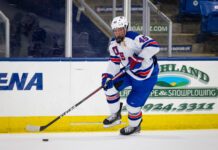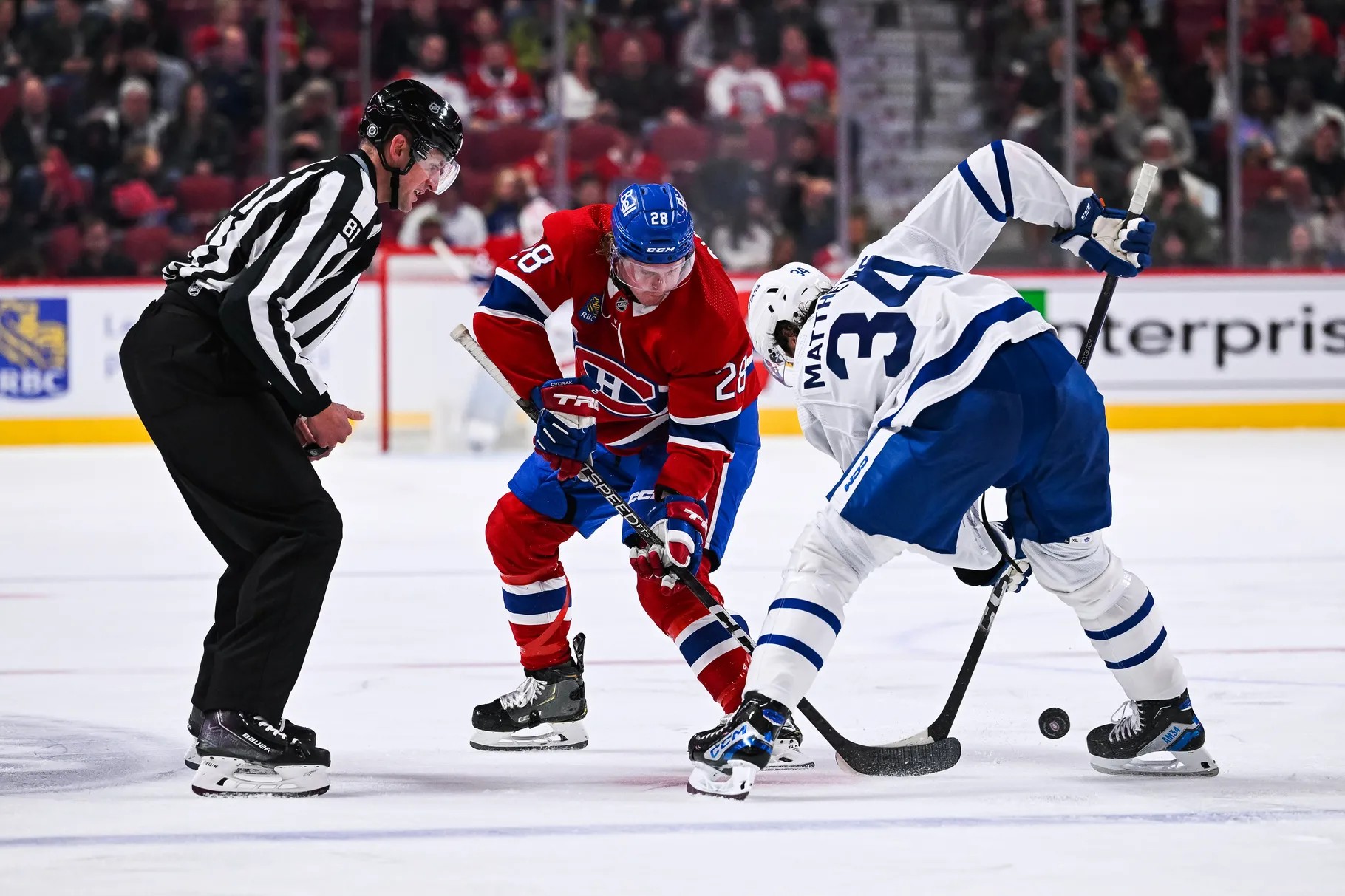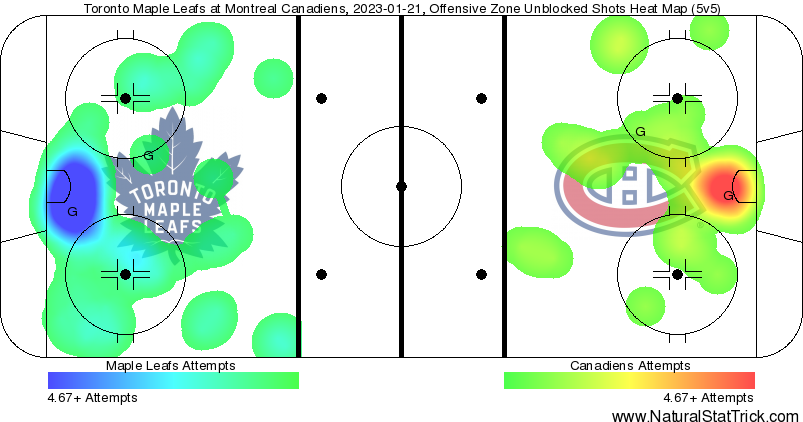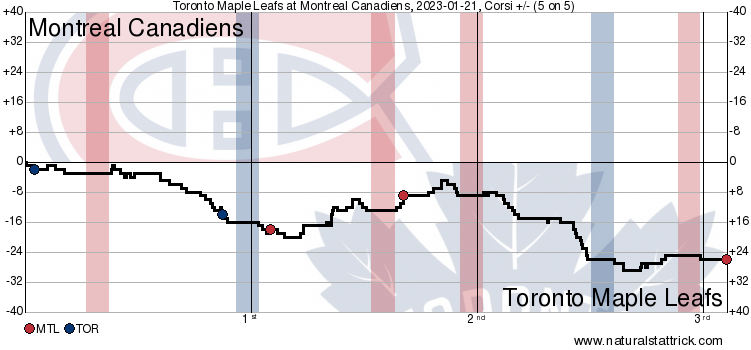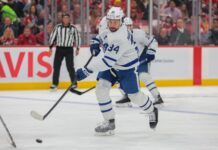Losing streaks against the Arizona Coyotes and consecutive losses to the Montreal Canadiens at the Bell Centre: two things that have lasted four games too long for the Maple Leafs.
Your game in 10:
1. The Maple Leafs got off to the perfect start under a minute into the game thanks to a nice goal by Mark Giordano, whose amazing career was highlighted before the game on the Hockey Day in Canada broadcast from Owen Sound, where Giordano played junior. He initiated the breakout with a little bump pass to Auston Matthews through the middle of the defensive zone, took off up ice to bring numbers into the rush, grabbed a pass from Matthews as the trailer, and buried it with a good shot to the low blocker side.
It was a quality finish serving as a reminder that Giordano has scored 21 goals as a defenseman before in this league (and racked up a 17-goal, 74-point season as recently as 2019).
MARKY G!!! 🗣 pic.twitter.com/aCZkknvQt9
— Toronto Maple Leafs (@MapleLeafs) January 22, 2023
2. The stats ended up totally one-sided for the Leafs by the end of the opening 20 minutes, but the shots were actually 3-3 as far as 12 minutes in. The Leafs had some nice rushes and looked dangerous on a few quick transitions, but they were one-and-done mostly and didn’t sustain all that much offensive-zone time. The first 12-13 minutes were pretty evenly played until a couple of really nice shifts from the Bobby McMann – David Kampf – Pierre Engvall line began to tilt the ice and create some momentum.
In the wake of that momentum, Calle Jarnkrok picked up a back-door tap-in off of a nice rush by Mitch Marner and good activation down the wall + back-post pass from Conor Timmins, making it 2-0. The fourth line followed up the third line with a few good shifts, including drawing a penalty late in the period.
Wait 'till you see this Timmins apple 🍎 pic.twitter.com/TdMbYroQh3
— Toronto Maple Leafs (@MapleLeafs) January 22, 2023
The Leafs’ top two lines hadn’t dominated per se, but they each contributed a goal in the first period, the bottom six was giving the Leafs some energy, and the defense had activated nicely to create a couple of goals. Toronto led 15-4 on shots, 22-6 on shot attempts, and 2-0 on the scoreboard by the end of the 20 minutes. All seemed to be going according to script with a solid team effort to take care of business against an injury-depleted Habs team.
3. The second period was uncharacteristically lifeless from the Leafs, who are typically a dominant team with the long change but owned just 12% of the expected goals in one of their poorer periods of the season.
I am not sure if they thought the Habs were going to lay down at 2-0, but the Leafs were playing at cruising speed for too long in the middle 20 after the Habs made it 2-1. It has not been the Canadiens’ M.O. very often under Martin St. Louis to give up on a game — and it certainly hasn’t been their M.O. against the Leafs in the Bell Centre the past few years. To not show much killer instinct on HNIC in a barn where the Leafs have left with their tail between their legs too often in the past few seasons was a little disappointing. The Habs were just the hungrier team in the period.
4. It didn’t help that the Leafs conceded so early in the second period to give the Habs some belief again (the shots were 17-4 at the time for Toronto).
Amidst another offensive-zone shift for the McMann – Kampf – Engvall line, Mark Giordano missed on a pinch, but Bobby McMann was covering for him tracking back. McMann and Justin Holl didn’t kill the play inside the defensive blue line along the wall, though. Rem Pitlick was able to make a play into the middle of the ice to Nick Suzuki, who had Josh Anderson streaking down the far wing for a one-timer that he made no mistake on.
It might’ve been a cleaner 3v3 sort-out if Giordano shaded closer to Anderson coming back, but it was a play that should’ve been killed on the wall before it ever happened with the Leafs’ numbers in the area.
It never fails, by the way. Anderson produces like 30-40 point-player against the rest of the league and becomes an All-Star against the Leafs.
5. After the game, it was interesting to hear Sheldon Keefe pinpoint a shift with 13 minutes left in the second as a particularly bad sequence from the team. That was the shift where it was a minor miracle that the Habs didn’t score to make it 2-2; Ilya Samsonov made three or four saves in quick succession, one of which he knew nothing about as he was lying down on the ice when the puck hit him in the side of the head.
The Leafs’ top line of Michael Bunting – Auston Matthews – William Nylander was on the ice for that shift with the Rasmus Sandin – Conor Timmins pairing, and they were standing around flat-footed in the defensive zone as the Habs aggressively attacked the net with little resistance. When the top line got back to the bench, Keefe gave them a death stare and chewed them out as they hung their heads. He seemed to be staring at Nylander, in particular — possibly because he let Josh Anderson skate right by him untouched to get to a loose puck in front.
It was a case of going through the motions for the Leafs’ stars at points in that middle frame.
6. The 2-2 goal for the Habs came on another rough shift in the second period from the top line plus the Ramus Sandin – Conor Timmins pairing. It was a broken play where Sandin swiped at the loose puck and it snuck through to Michael Pezzetta, whose shot left a rebound for Rafael Harvey-Pinard to finish off (no chance for Ilya Samsonov).
Initially, it was a bit of a miscommunication on the 3v3 situation from the Leafs; Sandin motioned for Michael Bunting to pick up Harvey-Pinard, who wasn’t picked up and would’ve had an open net if the initial pass connected (they got a little lucky the pass hit Bunting’s skate). After the bounce off of Bunting’s skate and the missed swipe by Sandin, Harvey-Pinard ended up finishing off the play in tight anyway.
7. One line that was giving the Leafs some really good and consistent efforts in this game was the Bobby McMann – David Kampf – Pierre Engvall trio. They played a role in getting the Leafs going in the first period prior to the 2-0 goal (as mentioned earlier) and nearly won the game for them in the third period.
McMann’s excellent forecheck should’ve led to a go-ahead goal for Kampf. McMann barrelled down on the puck, caught Samuel Montembeault out of his crease, and threw it out front for a glorious scoring chance. A TV timeout followed, and Keefe kept that line out there afterward for the next offensive-zone faceoff.
McMann is still without a point through five games, but he has created enough opportunity with his fast and physical straight-line game and his second-effort plays on the forecheck to have a couple of points with a little more luck. He is sitting at a 61% on-ice shot attempt percentage and a 66% xGF percentage through five games — a tiny and fairly meaningless sample, but both numbers lead the team, just to punctuate the point about the amount of time he’s spent in the right end of the rink.
8. The third period was mostly a pretty good response from the Leafs coming off of their sleepy second period, but they could not solve Montembeault. They controlled over 75% of the shot attempts and over 85% of the expected goals in the final 20 minutes.
After they couldn’t capitalize, it was nearly the season-opening loss repeated with a late-losing goal in the final three or so minutes. Kirby Dach broke in alone on Ilya Samsonov, who made a good pad save. During some four-on-four action, Joel Edmundson stepped into one on a clean draw loss by the Leafs for a howitzer from the top of the circle that Samsonov fought off. After a late William Nylander high-sticking penalty in the offensive zone, Suzuki walked around Mark Giordano and was in alone during a four-on-three power play for Montreal, but Samsonov was there again. On the same power play, Dach rang the bar with Samsonov beaten.
Samsonov came up with some huge saves to salvage the point in what was a physically taxing game for him in the net. In addition to taking a few hard shots up high to the neck/face area and having the Habs jam at his head during a scramble in the second period, there were two plays late in the third where he took a couple more licks. Kirby Dach ran into him — the ref gestured that it was a force-in by Auston Matthews — before Dach (again) and Mike Hoffman crashed the net, clipping Samsonov just seconds later.
Samsonov really hung in there and battled to make sure the Leafs got out of Montreal with at least a point. The response from his teammates in the moments after he took those knocks wasn’t the most emphatic.
9. Three-on-three OT started according to plan with David Kampf winning the opening faceoff, the Leafs possessing the puck, and Kampf getting off the ice for Auston Matthews. Matthews had one semi-dangerous curl-and-drag in the left circle that Montembeault stopped, but the majority of the chances afterward went to the Habs before the Rem Pitlick game-winner. It was a long shift for John Tavares, who was playing defense against the fresher legs of Pitlick and didn’t do much to disrupt the winning shot, which was well-placed into the top corner.
A point was squandered, and the Leafs fell to 4-7 in three-on-three OT this season.
10. Elliotte Friedman linked Vladislav Gavrikov to the Leafs (and Oilers) at the second intermission of HNIC. It’s a move that makes some sense provided there are some assurances around a contract extension, and reportedly, Jarmko Kekäläinen is permitting interested teams to talk about a contract with Gavrikov.
If you’re projecting out the Leafs’ defense for the next 18 months, Jake Muzzin seems unlikely to return at this point, although we’re nearing the time when we are supposed to receive a more concrete update on his status (expected sometime in February). Justin Holl is currently a pending UFA. TJ Brodie will be 33 next season and playing the final year of his contract. Mark Giordano will be 40 and playing in the final year of his.
There is sound logic in the Leafs proactively exploring the market for a prime-aged defenseman (Gavrikov is 27) who can handle tough minutes inside the top four. If they could add one to aid with the 2023 playoff run in the process, it would certainly better set them up to take on opposition with the star power and depth of Boston and Tampa.
At $2.8 million, Gavrikov is not too difficult to fit under the cap, especially if the Leafs could convince Columbus to hold onto a little bit of money for the rest of the season. I also don’t necessarily see it as an either-or thing with a defenseman versus a forward. Muzzin (presumably) remaining on LTIR gives the Leafs some space, and they should be creative with retention. They have 12 picks in the next two drafts — including both first-rounders — as well as some coveted prospects.
Look no further than Joe Sakic’s 2022 trade deadline for an example of a GM filling multiple needs (a top-four D in Josh Manson, a top-six wing in Artturi Lehkonen, and veteran depth up front in Andrew Cogliano) and getting rewarded for it in June. Sakic negotiated 50% retention on those three acquisitions, moved out Tyson Jost’s $2 million, gave up two second-round picks, a fifth-round pick, 2020 25th overall selection Justin Barron (RHD), and 2019 47th overall selection Drew Helleson (RHD). He did it all without his 2022 first-round pick as a trade chip (it was dealt in the Darcy Kuemper trade the summer prior).
In a division this tough, it’s probably similarly going to require the right series of moves for the Leafs to successfully conquer the challenge.
There are some huge ifs here, of course. What is the acquisition cost? The Ben Chiarot trade price (first + fourth + mediocre prospect) that is setting the initial ask here is rich, but the Manson price (second-round pick, prospect) seems more in the ballpark of a real conversation. Additionally, how big of a contract offer will it take to prevent Gavrikov from testing the open waters? All of that said, Dubas carrying out his due diligence on this makes sense to me.

















